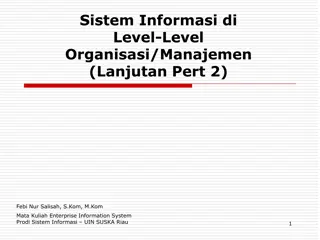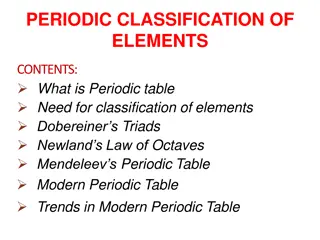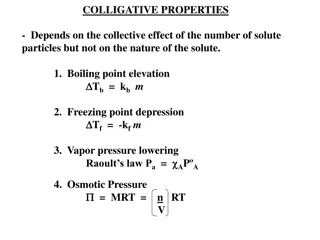Number Systems and Properties
Discover the representation of numbers and arithmetic operations to master addition, subtraction, multiplication, and division. Understand the commutative, associative, and distributive properties in different number systems such as natural numbers, integers, rational numbers, and real numbers including irrationals. Dive into the concept of irrational numbers and their place in the real number system.
Uploaded on Apr 19, 2025 | 0 Views
Download Presentation

Please find below an Image/Link to download the presentation.
The content on the website is provided AS IS for your information and personal use only. It may not be sold, licensed, or shared on other websites without obtaining consent from the author.If you encounter any issues during the download, it is possible that the publisher has removed the file from their server.
You are allowed to download the files provided on this website for personal or commercial use, subject to the condition that they are used lawfully. All files are the property of their respective owners.
The content on the website is provided AS IS for your information and personal use only. It may not be sold, licensed, or shared on other websites without obtaining consent from the author.
E N D
Presentation Transcript
www.studymafia.org Seminar On Brand Management Submitted To: www.studymafia.org www.studymafia.org Submitted By:
CONTENT Introduction What is brand management? History Responsibilities Benefits Types Working Examples Conclusion
Introduction To improve the quality and consistency of the brand names we share with our customers, Lowe s has implemented a new process to control the brand name field. In the past, vendors could submit their brand name any way they wanted, which meant there were frequent errors and inconsistencies in how the brand was presented. Because this data is used for selling tools such as Lowes. COM, customers would be confused by the different versions of the same brand name.
What is brand management? Brand management is a broad term used to describe marketing strategies to maintain, improve and bring awareness to the wider value and reputation of a brand and its products over time. A strong brand management strategy helps to build and nurture closer relationships with its audience. By building a loyal customer base, a brand s reputation and associated products will be perceived more positively, subsequently driving higher revenue and better brand equity.
History In 1872, on the eve of a national depression, the people in the tiny community of Eugene City decided to build a university for the state of Oregon. They thought it would be good not only for the future of their children but also for the future of the town. The city's leaders thought a university would bring both economic and social development to the community. The people of the town paid for the construction with private donations. They canvassed for cash contributions, held bake sales, farmers donated bushels of wheat or livestock to be converted into cash for the university effort. Others gave their services or day labor to help in the construction. By 1876, enough of the construction had been completed to allow classes to begin.
Responsibilities Monitor, measure and manage brand equity/strength Increase brand awareness, relevant differentiation, value, accessibility and emotional connection Develop brand plan Monitor progress against brand plan Be responsible for results against brand plan Drive brand understanding and support throughout the organization Champion/drive initiatives that support delivery of the brand promise Brand messaging elevator speech, tagline, campaign themes, proof points, etc.
Benefits of brand management? It fosters brand trust by creating a positive perception and adding credibility to your business and brand name. It helps you build a strong brand that delivers meaningful and impactful brand experiences. It encourages customer engagement and advocacy, leading to positive word-of-mouth marketing. It can help you drive additional sales and conversions from loyal customers.
Types Product brands These are the fast-moving inexpensive consumer goods (e.g. drinks, personal care products, confectionary, etc.) and the big-ticket expensive items (e.g. jewellery, appliances, and cars). Service brands To brand something you cannot touch and something that is delivered directly by employees is never easy. This is because in this type of brand, the service is essentially the thing that represents the brand.
Examples of brand management Example 1 A car insurance company develops a brand management strategy to promote brand awareness and recognition and foster familiarity within its target audience. Throughout the course of their marketing and advertising campaigns, they decide to partner with an easily recognizable spokesperson for their television ads. This spokesperson is a well-known actor who currently appears in a popular television show, has a large fan base and possesses a reputation for trustworthiness and integrity.
Examples of brand management Example 2 A toothbrush company works on a marketing campaign and brand management strategy to maintain consistency while introducing its new line of children's toothbrushes. When designing their packaging, they decide to sell their toothbrushes in boxes shaped like items such as a rocket ship, dinosaur, castle and unicorn using the same colors and logos as their line of adult toothbrushes. By associating this product line with other items children enjoy, the company increases brand recognition through associative thinking and familiarity but remains consistent by using the same colors and logos used in its adult line.
CONCLUSION Done not by dissecting brand management into its specific components, but by illustrating the robustness of brand management when placed appropriately in an organization.
References www.studymafia.org www.google.com www.wikipedia.com






















